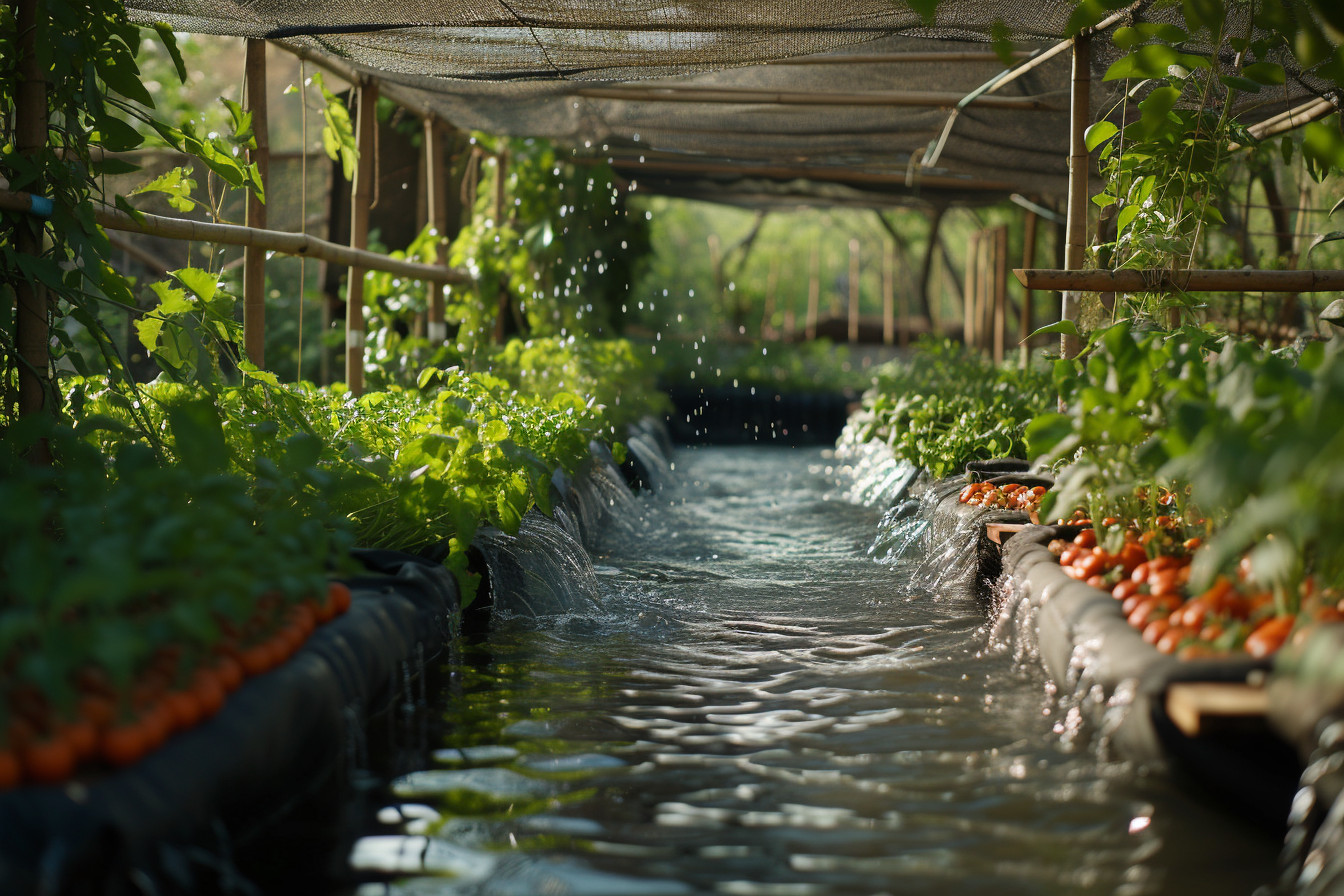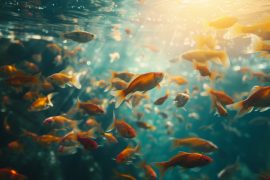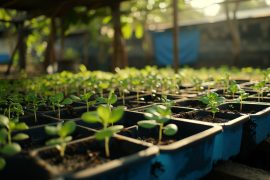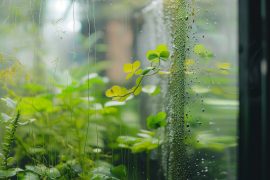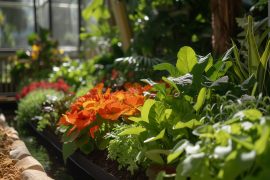Imagine living in a world where food scarcity isn’t the headline of every other news story. It’s not a far-off dream but something that could become reality with systems like aquaponics playing hero roles. I mean, think about it: combining fish farming (aquaculture) and soil-less plant cultivation (hydroponics) to create an efficient cycle? You’ve got to admit, that’s kind of genius! Now picture this: leafy greens thriving above while tilapia or maybe even shrimp help nourish them from below, all happening without the need for vast tracts of agricultural land.
This is exactly why I’m hooked on aquaponics as more than just a gardening technique—it’s potentially a game-changer for global food security and sustainability. What if we could truly decentralize how and where our foods are grown? Achieving self-reliance in villages hit hard by climate change sounds almost too good to be true, yet here we stand at its threshold thanks to innovations like these!
The connection between aquaponics and food security
Diving right into it, I’ve got to say, that the link between aquaponics and tackling global hunger isn’t just cool—it’s transformational. Imagine this: a world where every community has access to fresh veggies and fish without needing vast tracts of land or gallons upon gallons of water. That’s not some distant dream; it’s happening now with aquaponics.
Now for those scratching their heads wondering what on earth I’m chattering about—aquaponic systems are like magic gardens combining fish farming (aquaculture) with soil-less plant cultivation (hydroponics).
Fish waste provides nutrients for plants while the plants clean up the water for fish—a win-win scenario! Not only is this system sustainable, but it is also incredibly efficient. You can grow a heck lot more in a smaller footprint compared to traditional agriculture—and that, my friends, is downright crucial when we ponder over our ever-growing population and shrinking arable land.
Here’s something that threw me off—in regions suffering from poor soil quality or inadequate rainfall, conventional farming practically throws in the towel. However, roll out an aquaponic setup there, and bam! It turns barren wastelands into productive green spaces capable of feeding hundreds, if not thousands!
To give you hard numbers because, let’s face it, the facts speak volumes:
| Region | Increase in Production Using Aquaponics |
|---|---|
| Sub-Saharan Africa | Up to 90% |
| Southeast Asia | About 50–75% |
Seeing these statistics virtually yells at how pivotal such systems could be towards ensuring everyone gets enough grub on their plates daily.
But wait—the goodness doesn’t stop there.
- Water-wise, it uses up to 90% less H2O than old-school gardening.
- Eco-friendly Ride: Say no to toxic pesticides since they’re harmful to enclosures’ inhabitants.
Honestly speaking, as someone deeply passionate about both tech innovations aiding society at large and concerns surrounding climate change, this strikes much-needed optimism within hearts, including mine beyond a shadow doubt, which highlights the potential to touch the lives of many around the globe, opening enthralling avenues. Buffering against threats looms a dreadful monster called ‘World Hunger’.
Advantages of aquaponics in addressing global hunger
Aquaponics, the blend of aquaculture (raising fish) and hydroponics (growing plants without soil), has emerged as a beacon of hope for tackling global hunger. This innovative method offers several distinct advantages that could significantly alter how we produce food on our increasingly crowded planet.
First off, let’s talk about water efficiency. Aquaponic systems recycle water between fish tanks and plant beds, resulting in up to 90% less water usage compared to traditional farming methods. Given that agriculture accounts for about 70% of freshwater use globally, according to the FAO (Food and Agriculture Organization), this level of efficiency isn’t just remarkable; it’s essential.
- Water savings: up to 90% more efficient
- Freshwater usage by agriculture worldwide: approximately 70%
Then there’s yield—oh boy! Plants grown in aquaponics mature faster, thanks partly to always having access to the necessary nutrients released by any little swimming partners. This means you can harvest your lettuce, tomatoes, cucumbers, and so many other crops quicker than if they were dirt-bound, meaning more food rounds per year.
And when talking about space, these setups really highlight something special since you’re literally stacking functionality. Every square foot does double duty, supporting both aquatic life-form-based spaces and vegetal growth. That is agronomic wizardry right there, paving the way toward eradicating perpetual shortages of food supplies in areas impacted by harsh conditions like drought or poor soil fertility.
Case studies showcasing aquaponics’ impact on food security
Diving deep into the world of sustainable agriculture, we find some shining examples where aquaponics has made a real difference. Picture this: communities that once struggled to find fresh produce are now thriving thanks to these ingenious systems.
Let’s talk about a project in Barbados. After facing years of water scarcity and soil issues, locals turned towards an innovative solution—introducing an island-wide initiative for small-scale aquaponic setups. What’s thrilling is how quickly they saw results:
| Before Aquaponics | After Implementing Aquaponsystem 6 Months Later” |
|---|---|
| Limited accessibility resulting from fish available year-round |
The beauty here is not just in the numbers but also in the stories: families sharing meals with veggies picked right from their backyard fish tanks!
Now picture urban centers across the USA changing the urban landscape, forebracing a greener future. Milwaukee, Wisconsin, stand as a testament to the power of city folks embracing farm life.
Challenges and limitations of aquaponics in addressing global hunger
Diving into the world of aquaponics as a solution to combat global hunger, it’s easy to get excited by its potential. Yet, we’ve got to acknowledge that there are real challenges and limitations here too. It’s not all smooth sailing—or, should I say, farming?
First off, one big challenge is the startup costs associated with setting up an aquaponic system. They’re not exactly pocket change for many communities facing food insecurity around the globe. We’re talking about needing resources for tanks, pumps, grow beds—you name it!
For folks just trying to make ends meet or in areas where even basic infrastructure is lacking, these initial investments might seem like a mountain instead of a molehill.
- Startup Costs: These can include anything from equipment procurement (think tanks and filters) right down to effects on local biodiversity.
Another point is to consider scale. Aquaponeems thrive on small and medium scales, but when you think endings aren’t necessarily silver bullets, widespread adoption across diverse geographies comes with set complications: climate suitability, matching crop types, and available water quality. Not every region easily adapts its framework to its needs. Without considering those variables, effectiveness diminishes.
Lastly, potential environmental impacts cannot be ignored in intensive systems, particularly ones that rely heavily on inputs to control environments and cause situations.
Where balance tips in the wrong direction, unintended consequences such as wildlife being displaced due to expansive installation operations Sustainability is key to ensuring we don’t end up creating more problems. To be part of the bigger picture, sustainable agriculture must weigh benefits alongside possible drawbacks. carefully navigate through murky waters. innovating without compromising the integrity of ecosystems at large.
Future potential and scalability of aquaponics for food security
Diving into the realm of aquaponics feels a lot like stepping into a sci-fi novel, yet it’s incredibly grounded in its promise to combat global hunger. Imagine this: plants growing robustly above water where fish swim serenely beneath—this harmony not only paints an idyllic picture but also packs a punch against food insecurity.
At first glance, you might think that such systems need high-tech wizardry and deep pockets. But here’s the kicker: they’re surprisingly achievable and scalable, from small backyard setups to large-scale operations feeding thousands. It’s all about utilizing what we’ve got more effectively while cutting down waste big time!
Let me throw some numbers atcha:
| Scale | Output (kilograms per year) |
|---|---|
| Small Home System | 50-2200 |
| Medium Community Hub | 1,000–5,000 |
| Large Commercial | Over 20,000+ |
These figures aren’t just impressive—they symbolize how adaptable and expansive aquaponic systems can be.
Anecdotes aside—and I’ve heard many—the real beauty is seeing communities turn barren plots or unused warehouses into thriving green spaces filled with vegetables and marine life alike!
From urban rooftops in New York City transforming wasted space into bountiful harvests to rural areas harnessing these self-sustaining ecosystems, it’s clear there isn’t ‘one size fits all’. This flexibility ensures that wherever you are on this planet, there could potentially be an efficient way nearby to produce your own sustainable source of nutrition through aquatic agriculture.
Now let’s talk about the nitty-gritty details because dreaming big is good, but making those dreams a reality means understanding practicalities:
- Location matters, but less than you think since these units recycle their resources.
The result? A game-changer particularly valuable in regions battling freshwater scarcity—a critical factor when traditional farming gulps down approximately globally [70%] fresh water supply alone!
This method marries efficiency with environmentalism by essentially mimicking Mother Nature herself—not too shabby, eh?
Wrapping up—I hope I’ve painted vivid enough strokes illustrating both current impact and future promises held within the realms of expanding our perception towards crop production via integrated fisheries, aka Aquaphonic routes!
Envisioning such fuels optimism around addressing pressing issues like global hunger sustainably—isn’t progress delightful?
Final Thoughts
This is the conclusion. Diving into aquaponics has been quite a journey! From fish tanks to grow beds, I’ve explored every nook and cranny of this fascinating world. It’s not just about growing food or raising fish; it’s about securing our future in terms of food.
Let me share some numbers with you:
| Aspect | Fact |
|---|---|
| Water Efficiency | Aquaponics uses up to 90% less water. |
| Growth Rate | Plants can grow twice as fast. |
| Land Use | Requires only a fraction compared to traditional farming. |
Mind-blowing, right? But beyond these statistics lies something deeper: the peace and connection with nature that gardening brings, which aquaponic systems epitomize beautifully.
- Food Security: With increasing populations but decreasing arable land, we’re at risk, yet here’s aquaponics doubling down on solutions.
- Education and Community Involvement: Schools have started incorporating it, teaching kids sustainability practices firsthand, while community centers bring people together for greater self-sufficiency.
Now if there are two takeaways from my deep dive into the watery worlds beneath those lush floating gardens, they would be ‘hope’ and ‘innovation’. While tackling global hunger feels like battling against an ever-growing goliath, facts show us technologies like aquaponics hold keys to unlocking doors towards sustainable futures.
Yet what truly resonates after all these words spilled across pages isn’t merely improved efficiencies or startling rapid growth rates—it’s simpler, calmer, and more introspective than that. A melding between humanity, agriculture, and technology where each finds balance within another aimed squarely at coexistence without compromising one little bit of Earth’s natural magnificence.
